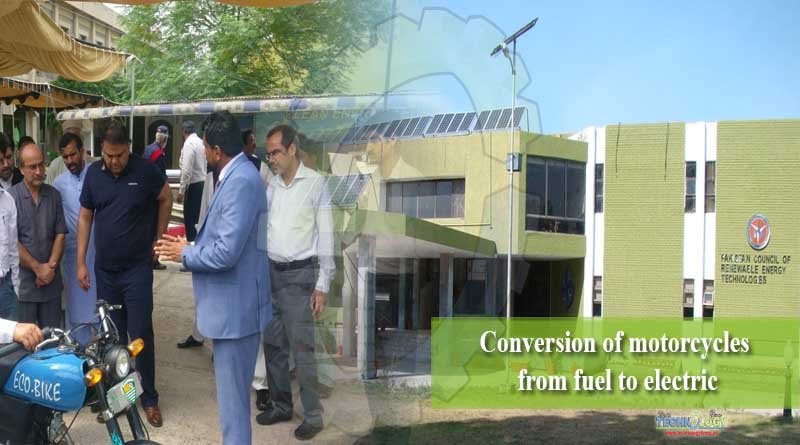So, finally the Government has announced to shift all motorcycles from fuel to electric. In his visit to Pakistan Council for Renewable Energy Technologies (PCRET) on August 29, 2019.
 Mr. Fawad Ch. Minister of Science and Technology drove a hybrid motorcycle (developed by the Department of Mechanical Engineering of Mirpur University of Science and Technology).
Mr. Fawad Ch. Minister of Science and Technology drove a hybrid motorcycle (developed by the Department of Mechanical Engineering of Mirpur University of Science and Technology).
Mr. Chaudhary confirmed that emissions from motorcycles and rickshaws are a major threat and therefore conversion of all motorcycles and rickshaws to electric system is indispensable.
Motorcycles are one of the dominant transportation modes in many Asian countries including Pakistan. Pakistan is the 5th largest motorcycle market in the world after China, India, Indonesia, and Vietnam. With 7,500 new motorcycles being sold every day, Pakistan is also among the world’s fastest growing two-wheeler markets.
Passenger car and motorcycle sales in Pakistan are both soaring at rates of over 20% a year. A continuous and rapid increase in the number of motorcycles has made exhaust pollution one of the major emission sources in major cities of Pakistan, such as Lahore and Karachi. On the other hand, an increase in petrol prices has added salt to the wounds of motorcycle holders in Pakistan.
Motorcycles are a significant source of air pollution, especially in carbon monoxide (CO), Nitrogen Oxides (NOx) and hydrocarbon (HC) emissions. Oxides of nitrogen are one of three pollutants the Environmental Protection Agencies measure to see whether vehicles meet acceptable emissions levels and can be sold legally.
In terms of Carbon Dioxide (CO2), a motorcycle emits (approximately 50-90g/km), i.e. 30% less CO2 than a car (approximately 152g/km). However, a motorcycle emits much higher concentrations of smog-forming emissions such as CO, NOx and HC than a car on per km basis.
The Table below shows the results of a research published in the Journal of the Brazilian Chemical Society, in which the research team measured the emissions from motorcycles and cars. It is apparent that a motorcycle emits 18% more CO, 50% more NOx and 349% more HC than a car on per km basis.
Vehicle Type | Emissions | ||
CO (g/km) | NOx (g/km) | HC (g/km) | |
Motorcycle | 0.702 | 0.066 | 0.175 |
Car | 0.595 | 0.044 | 0.039 |
A similar study was conducted in the National Taiwan University which concluded that one motorcycle’s THC and CO emissions were equivalent to the emissions from 12 catalyst cars. These studies confirm that motorcycles emit more concentrations of CO, NOx, and HC than cars.
These higher concentrations of CO, NOx and HC emissions from the tails of motorcycles are directly responsible for smog formation. In a country like Pakistan which has become the fifth largest motorcycle market in the world with a daily sale of 7,500 motorcycles per day, the contribution of motorcycle emissions has become one of the leading sources of poor air quality and smog formation in the major cities.
At the same time, these emissions are responsible for many diseases which include anomalies in the upper respiratory tract, lungs cancer and eye infections, especially conjunctivitis. Air quality in Pakistan exceeds safe limits in all major cities causing 135,000 deaths per year, making it the leading cause of sickness and death in Pakistan, as well as reduced life expectancy by 60 months.
Major cities of Pakistan such as Lahore has already suffered from severe smog with its air pollution exceeding safe limits by nine times. One of the possible reasons is the increasing number of motorcycles in Lahore.
A report prepared by World Health Organization has revealed that Lahore is one of the worst 50 NOx hotspots in the world with 40 per cent of emissions coming from road transportation and 23 per cent by power generation.
The other loss due to this increasing air pollution is the financial loss. According to a report, more than 5.88% of GDP or $47.8 billion is the estimated economic burden of air pollution in Pakistan.
Pakistan has a population of approximately 200 million. Assuming each home has five family members, means there are 40 million homes in Pakistan. Further assuming that 60% of these homes have a motorcycle, means there are approximately 24 million motorcycles in Pakistan.
Considering this assumption, there are nearly 14.4 million, i.e. 60% of total motorcycles in Punjab only and 1.4 million in Lahore. With a current production and selling rate of 2.5 million motorcycles per year, the total number of motor cycles in Pakistan by 2025 will become 41.5 million (42% increase) and 54 million by 2030 (56% increase).
According to a report published in Dawn Newspaper, daily average traveling by a motorcycle in Pakistan is 50km. This means the annual travel by motorcycle is 18,250km with an annual petrol consumption of 261 Liters. This means each motorcycle emits 13kg of CO, 1.2 kg of NOx, 3.2kg of HC and 1,825kg of CO2 on a yearly basis.
This makes total CO2 emissions from motorcycles in Pakistan as approximately 31Million Tonnes of CO2 (nearly 16% of Pakistan’s total CO2 emissions). This means that in next 10 years, the air quality in the major cities of Pakistan will further deteriorate, making the lives of people miserable. Diseases such as lungs cancer are expected to spread leading to higher death rates in major cities of Pakistan because of environmental pollution.
So, do we have a solution? Is there a way to mitigate these increasing smog-forming emissions from motorcycles? There are two options for us:
- Use of fully electric motorcycles
- Use of hybrid motorcycles (Petrol and battery)
Electric motorcycles may not be a suitable solution for Pakistani motorcycle community as in Pakistan, we use motorcycle for different heavy tasks which means motorcycles would run on heavy load. However, hybrid motorcycles may be a sustainable solution in terms of both the economic and environmental aspects.
A hybrid motorcycle could be run on either petrol or on a battery. A recent study was undertaken at the Mirpur University of Science and Technology (MUST) reveal that a hybrid motorcycle could be the way forward for tackling the economic and environmental issues in the major cities of Pakistan.
The research team converted a normal CD 70 motorcycle into a hybrid motorcycle by installing a hybrid kit into it. The hybrid kit included a 1000W hub motor, 20AH battery, a charge controller, an inverter, a charger, an accelerating lever, and a display.
The hub motor is installed into the front wheel whereas the battery was placed under the driver seat. The research team conducted various experiments and concluded the followings:
- When running on a plain road with a single rider, the hybrid motorcycle can travel 50km per battery discharge.
- One full battery charge takes about one to two hours and consumes only one unit of electricity, i.e. 1 kWh.
- If the unit price of electricity is Rs. 10, this means, one can travel 50km in only 10 rupees, i.e. 20 paisa per km. But for the same distance, if the rider runs motorcycle on petrol, the cost of traveling 50km is almost 108 Rupees, i.e. Rs 2.16/km, i.e. 980% higher than that on battery.
- Considering the battery is charged with grid electricity, the one unit of grid electricity will emit 0.59kg of CO2 This means one can travel 50km by emitting only 11.8g of CO2 / km. whereas if the rider had traveled this 50km on petrol, the total emissions will be approximately 46g/km, i.e. 290% higher than that on battery.
- The research team further recommended that motorcycle must be run on battery when the rider is a single rider. For example, when a father takes his three kids to school, he may run his motorcycle on petrol, but on the way back when he is alone, he should switch over to battery. This way, he can still save money and will emit lesser emissions.
- The hybrid motorcycle offers both options. Whenever needed, the rider can switch over to petrol or battery.
- The cost of this hybrid kit could be recovered within one to two years through the financial savings on fuel.
- If all the motorcycles are converted to hybrid motorcycles, the motorcycles’ emissions could be reduced by more than 80%.
In the nutshell, the increasing number of motorcycles are one of the major sources of smog-forming emissions and noise pollution in the major cities of Pakistan. Switching over from conventional motorcycles to hybrid motorcycles can bring a significant improvement in the air quality of the major cities of Pakistan and will reduce the burden on its hospitals.
If the Government wants to take action in this regard, it’s the time. Otherwise, in the next 5 to 10 years, the air quality of major cities will further deteriorate due to increased emissions from the increased number of motorcycles. To tackle this environmental threat, Government of Pakistan must consider promoting hybrid or electric motorcycles.
The production of this hybrid kit in Pakistan will generate employment and will help Pakistan in achieving its Sustainable Development Goals (SDGs) such as SDG 3 “Good Health and Well Being”, SDG 7 “Affordable and Clean Energy”, SDG 8 “Decent Work and Economic Growth”, SDG 9 “Innovation, Industry and Infrastructure”, SDG 11 “Sustainable Cities and Communities”, SDG 13 “Climate Action” and SDG 15 “Life on Land”.
The recent announcement by the minister of science and technology that the government is planning to shift all motorcycles to electric system is highly appreciated and precisely is a right step in a right direction.
Authors Bio: Dr. Khuram Pervez
Dr. Khuram is the Chairman of Mechanical Engineering Department at Mirpur University of Science and Technology (MUST), Mirpur, AJK. Dr. Khuram holds Ph.D. and Master of Science degrees in Sustainable Energy Systems from London South Bank University, UK and a Bachelor of Science degree in Mechanical Engineering. 
Dr. Khuram is ex-Energy Manager of the Queen Mary University of London. With over 19 years’ of professional experience in the fields of energy generation, energy management, sustainability along with academic experience, Dr. Khuram is a Chartered Engineer, Member of Energy Institute, Pakistan Engineering Council.